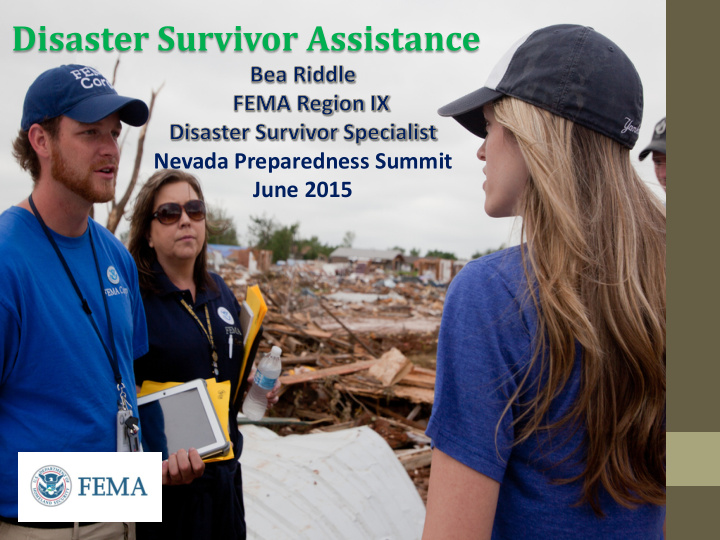



Disaster Survivor Assistance Nevada Preparedness Summit June 2015
Disaster Survivor Assistance Established • In an effort to focus on a survivor-centric approach to providing disaster assistance based on lessons learned in previous disasters, FEMA leadership: o Transferred the Community Relations program from the Office of External Affairs (OEA) to the Recovery Directorate, and o Changed the name of the cadre to Disaster Survivor Assistance (DSA) • DSA reports directly to Operations Section in the Joint Field Office (JFO). 2
DSA Mission • Build and sustain an expeditionary cadre that can address disaster survivor’s immediate needs by: o Establishing a timely presence; o Providing in-person, tailored information and services; o Providing referrals to Whole Community partners as needed; o Collecting targeted information to support decision-making; and o Identifying public information needs so critical messaging can be developed and disseminated. 3
Survivor Centric Focus • Register survivors where they live or work • Bring services directly to those who need them • Inclusion of Whole Community partners for provision of expanded program services • Use of technological tools to enhance mobile cap abilities 4
Value-Added of DSA • The DSA Teams are a professional “force multiplier” that will support State, Local, Tribal, Territorial and Federal requirements in the field by: o Quickly deploying in anticipation of (or immediately following) a disaster declaration; o Providing assistance to survivors who need the most help; and o Providing operational awareness of conditions, needs, and activity in the affected area 5
Five (5) Essential Functions of DSA Registration Intake Referrals to AIR Case Status Whole Inquiries Community and Partners Updates Survivor Needs 6 Assessment
Disaster Survivor Assistance Neighborhoods Phased Approach Local Government Community Groups Private Sector Town Hall DSA Essential Functions: Meetings 1. Assess, Inform, Report (AIR) Mission 2. Registration Intake Mobile 3. Case Status Inquiries & Updates Disaster Recovery 4. Survivor Needs Assessment Center 5. Referral to Whole Community Partners Disaster Recovery Center
DSA Outreach Products and Reports • DSA members working in impacted communities will distribute pre-approved collateral materials to include: Business Cards Flyers Brochures Fact Sheets Door Hangers Disaster Assistance Publications Spot Report, Daily Summary Report, AIR • Checklist 8
9
Technology Requirements • The benefits of implementing these operational requirements allow for a more agile mobile workforce that leverages technology to support survivors who need the most help. • The Disaster Survivor Assistance cadre is designed to function in a 100% mobile environment and the concept of operations requires field teams to provide services directly to disaster survivors on site and in person. 10
Technology • The Disaster Survivor Assistance crews utilize iPads to register survivors, perform case status inquiries and updates, and provide referrals to resources
Benefits of DSA • A new capability that builds on already existing resources within FEMA. • Meant to complement the already existing operational structure in the field. • Another option for survivors – Tele-registration, Web/Mobile Registration, Visiting Disaster Recovery Centers. • Provides real-time situational awareness of unmet needs, infrastructure issues, etc. • Additional surge staff to support states and local communities as needed. 12 • Another tool in the toolbox.
Next Steps… • Develop Work Plan and Strategy moving forward • Coordination with Whole Community Partners 13
Questions??? Bea Riddle, FEMA Region IX Disaster Survivor Specialist Bea.Riddle@fema.dhs.gov 225-910-5156 14
Recommend
More recommend